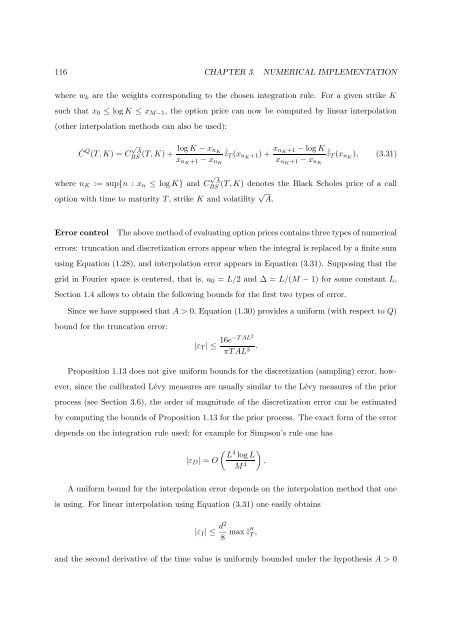Processus de Lévy en Finance - Laboratoire de Probabilités et ...
Processus de Lévy en Finance - Laboratoire de Probabilités et ...
Processus de Lévy en Finance - Laboratoire de Probabilités et ...
Create successful ePaper yourself
Turn your PDF publications into a flip-book with our unique Google optimized e-Paper software.
116 CHAPTER 3. NUMERICAL IMPLEMENTATION<br />
where w k are the weights corresponding to the chos<strong>en</strong> integration rule. For a giv<strong>en</strong> strike K<br />
such that x 0 ≤ log K ≤ x M−1 , the option price can now be computed by linear interpolation<br />
(other interpolation m<strong>et</strong>hods can also be used):<br />
Ĉ Q √<br />
(T, K) = C A<br />
BS (T, K) + log K − x n K ˆ˜z T (x nK +1) + x n K +1 − log K<br />
ˆ˜z T (x nK ), (3.31)<br />
x nK +1 − x nK x nK +1 − x nK<br />
√<br />
where n K := sup{n : x n ≤ log K} and C A<br />
BS<br />
(T, K) <strong>de</strong>notes the Black Scholes price of a call<br />
option with time to maturity T , strike K and volatility √ A.<br />
Error control The above m<strong>et</strong>hod of evaluating option prices contains three types of numerical<br />
errors: truncation and discr<strong>et</strong>ization errors appear wh<strong>en</strong> the integral is replaced by a finite sum<br />
using Equation (1.28), and interpolation error appears in Equation (3.31). Supposing that the<br />
grid in Fourier space is c<strong>en</strong>tered, that is, u 0 = L/2 and ∆ = L/(M − 1) for some constant L,<br />
Section 1.4 allows to obtain the following bounds for the first two types of error.<br />
Since we have supposed that A > 0, Equation (1.30) provi<strong>de</strong>s a uniform (with respect to Q)<br />
bound for the truncation error:<br />
|ε T | ≤<br />
16e−T<br />
AL2<br />
πT AL 3 .<br />
Proposition 1.13 does not give uniform bounds for the discr<strong>et</strong>ization (sampling) error, however,<br />
since the calibrated Lévy measures are usually similar to the Lévy measures of the prior<br />
process (see Section 3.6), the or<strong>de</strong>r of magnitu<strong>de</strong> of the discr<strong>et</strong>ization error can be estimated<br />
by computing the bounds of Proposition 1.13 for the prior process. The exact form of the error<br />
<strong>de</strong>p<strong>en</strong>ds on the integration rule used; for example for Simpson’s rule one has<br />
( L 4 )<br />
log L<br />
|ε D | = O<br />
M 4 .<br />
A uniform bound for the interpolation error <strong>de</strong>p<strong>en</strong>ds on the interpolation m<strong>et</strong>hod that one<br />
is using. For linear interpolation using Equation (3.31) one easily obtains<br />
|ε I | ≤ d2<br />
8<br />
max ˜z′′ T ,<br />
and the second <strong>de</strong>rivative of the time value is uniformly boun<strong>de</strong>d un<strong>de</strong>r the hypothesis A > 0
















